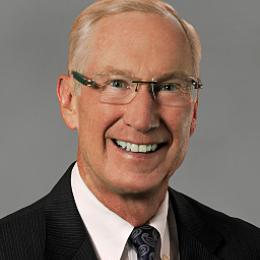By the time you read this, I will have retired from MassMutual, after spending more than 13 years with the company. Obviously, my tenure at, and departure from, MassMutual have been on my mind. The other night my wife asked me: “What caused you to have close, lasting relationships with team members at one company and very few from your time at other companies?”
I never thought about that before. Reflecting on my time at four Fortune 500 companies over the past 35 years (for 20 of which I reported to the CEO), I have observed there were some groups that truly enjoyed working with each other and had fun. We understood, helped, supported, and respected each other. At other times, when that team camaraderie was not present, I just concentrated on my job and looked forward to upcoming vacations. What was the difference?
During my career, I have observed two distinct leadership styles. There is the “hub-and-spoke” system where the leader is at the center. He — and it is almost always a man in this system — involves knowledgeable team members on a particular issue when making decisions.
Then there is the “cloud” or collaborative approach. Together, the team owns all the issues within their combined areas of responsibility. After a long career, it is my view that the cloud approach is much stronger. It allows the team to reach better decisions and obtain superior results. More leaders should and will adopt it going forward. This enables the development of a group that enjoys working, learning from mistakes, winning, and having fun. You want to develop a team, or work with a team, in the cloud.
In the hub-and-spoke model, the leader in the center views himself (again, an intentional use of that pronoun) as the smartest person in the room — and he often is. These leaders can make the right decisions with the appropriate facts and input, and sometimes despite the facts and input. For example, the CEO may interact directly with various business leaders to create strategies and tactics without input from the rest of the top leadership team. Other team members feel uninvolved and left out. How can they support a decision in which they had no involvement or input? The board, and maybe even an enterprising plaintiff in a derivative suit, will hold the entire team accountable for the result. What a mess! And keep in mind, if you are the smartest person in the room — you have a weak team!
When I have worked in this hub-and-spoke model and its accompanying culture, a peer recommendation, truly intended as a suggestion for improvement, is not valued. It is viewed as a personal attack. In this system, outside advice is not welcomed because the only relationship that matters is between the CEO and his reports. Of course, this kills any incentive for colleagues to help each other. This leads to the “not invented here” syndrome, which rejects outside ideas, no matter how helpful. How sad is that? I truly believe that feedback is a gift to help improve and grow. However, when input falls on deaf ears and is viewed as an attack, people eventually give up and retreat into silos.
When I was part of the U S WEST leadership team, our chairman and CEO was a believer in the cloud model. This made the general counsel role more expansive, valuable, and fun. My business partners encouraged the suggestions I made in their areas of responsibility. As general counsel, I rarely had a “dog in the fight” on business issues and was just only offering ideas to improve the overall enterprise. Instead of viewing my thoughts as a criticism or attack, they accepted and appreciated my input. It made us all a better and stronger group. It also forced me to learn about and become engaged in various aspects of the business outside the legal department, challenged my thinking, and made my job more rewarding.
In the cloud approach, the leaders are more “humble” and recognize they do not have all the answers (ergo, they are not the smartest in the room) — and they need the team’s help. We all have to be comfortable raising issues, and all must value each other’s different perspectives and opinions. The team needs to learn together and understand the objectives and challenges of fellow team members.
For example, when they all reported to me, the persons heading up, say, human resources and government relations must understand what lawyers are focusing on. Often expertise in what may be viewed as in an area totally unrelated to law can be used to advance our legal objectives. The environment is a comfortable, not competitive one. We do not compete against each other, but together work to win as a team against our business competitors.
The cloud model forces your team to learn about areas of expertise where they may have zero background and experience. This model requires your team to be curious. They will only be curious if they know their input will be valuable. I joined the U S WEST legal leadership team as a litigator with very little experience in corporate or other areas of the law, or even in the guts of the business. Our general counsel used the cloud model. He forced us to work together for better results. I had the freedom to explore, learn, and observe all. The model allowed him to move me from litigation to head up the entire corporate law practice, and later become assistant secretary. Without this approach, I would never have learned the various areas of law I needed to become a general counsel.
As part of the “cloud” leadership team at U S WEST, I remember one meeting in particular. We sat in a conference room and had to find US$80 million in savings to meet our investors’ expectations. I had volunteered what I would do in the legal space to reduce costs. And my peers in sales and in our network division said “NO WAY — we will cover you.” Now, that is a team! At other companies, there is a need to retain consultants to do this work because no one will listen to, or collaborate with, the other members of the department or company.
My last position at MassMutual was to handle all of the company’s technology. I put together a technology leadership team (all new to their responsibilities, but for one) that reported to me. And I asked them all to structure their organization, below me, to advance our company and technology strategies. It was truly fun to watch them work collaboratively to configure their teams — with “give and take” between them to achieve the best for the company. There were six of them, and I always had seven votes that could overrule them, but I can honestly say I never had to do that.
A cloud leadership team will achieve better outcomes in the most important area: people. Key employment decisions should be made as a team. Input from your peers is invaluable, in part to help to eliminate biases (one reason you need your team to be diverse). If team members can see the process and provide input on decisions like selections, promotions, compensation, rewards, and terminations, they will be more engaged and reach better decisions.
This is truly a pleasure to watch. I recently observed my team give up an allocation of long-term equity to another team member who had expended her allocation for use with her team because they all agreed the person deserved it. Yet at other companies, I had zero visibility into the decisions of my peers. This happened when a CEO and the human resources group operated in an opaque silo — typical of the hub-and-spoke model.
The cloud team approach is in many ways like a family. We may argue with each other on a particular issue. But with the opportunity for input, once decisions are made, we all support it — and nobody externally criticizes our family.
It is clear to me that the hub-and-spoke model also puts the company at greater risk. What happens if the CEO leaves? Or if the top leadership team is unaware of various decisions they make and there is no check on their behavior? Yet in the cloud model, not only are better decisions made, and results obtained, but there is visibility and a check on any actions of the leaders.
All winning companies — and leadership teams — are moving to the cloud. Great results will be achieved. And, as I told my wife, those are the companies where I had the most fun and enjoyed working with my fellow team members — while delivering stellar results for all.




